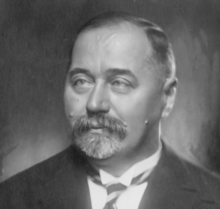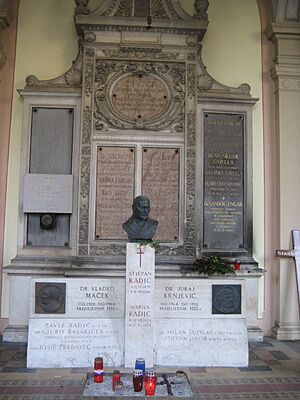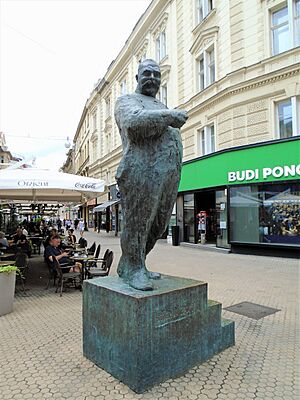Stjepan Radić facts for kids
Quick facts for kids
Stjepan Radić
|
|
|---|---|

Radić in the 1920s
|
|
| President of the Croatian People's Peasant Party | |
| In office 28 December 1904 – 8 August 1928 |
|
| Preceded by | Position established |
| Succeeded by | Vladko Maček |
| Leader of the Opposition | |
| In office 1 January 1921 – 8 August 1928 |
|
| Minister of Education in Kingdom of Serbs, Croats and Slovenes | |
| In office November 1925 – February 1927 |
|
| Personal details | |
| Born | 11 June 1871 Desno Trebarjevo, Kingdom of Croatia-Slavonia, Austria-Hungary |
| Died | 8 August 1928 (aged 57) Zagreb, Kingdom of Serbs, Croats and Slovenes |
| Resting place | Mirogoj cemetery, Zagreb, Croatia |
| Citizenship | Hungarian-Croatian (1871–1918) Yugoslav (1918–1928) |
| Political party | Croatian Peasant Party |
| Spouse |
Marija Dvořák
(m. 1898) |
| Children | Milica (1899–1946) Miroslav (1901–1988) Vladimira (1906–1970) Branislava (1912–1983) |
| Relatives | Antun Radić (brother) |
| Occupation | Politician |
Stjepan Radić (born June 11, 1871 – died August 8, 1928) was an important Croatian politician. He founded the Croatian People's Peasant Party (HPSS). He was active in politics during the time of Austria-Hungary and later in the Kingdom of Serbs, Croats and Slovenes.
Radić is known for helping Croatian farmers become a strong political group. He always opposed the idea of Croatia joining Serbia without having its own freedom. He became a very important political leader in the new country.
Sadly, he was shot in parliament by another politician, Puniša Račić. Radić died several weeks later from his injuries at age 57. This event made the relationship between Croats and Serbs much worse. It also led to the end of the parliamentary system and the start of a royal dictatorship in 1929.
Contents
Who Was Stjepan Radić?
Early Life and Education
Stjepan Radić was born in Desno Trebarjevo, a village near Sisak. This area was part of the Kingdom of Croatia-Slavonia within Austria-Hungary. He was the ninth of eleven children in his family.
He was expelled from his high school in Zagreb. But he finished his studies at the Higher Real Gymnasium in Karlovac. In 1888, he traveled to Kiev in the Russian Empire.
In 1891, he started studying law at the University of Zagreb. He was a student leader and spoke out against the Ban of Croatia, Károly Khuen-Héderváry. For this, he was sent to prison for four months.
In 1895, he and other students burned the Hungarian flag during a visit by Emperor Franz Joseph. Because of this, Radić was expelled from the University of Zagreb. He was also banned from all universities in the Austro-Hungarian Empire. After spending time in Russia and Prague, he continued his studies in Paris. He graduated in 1899.
Leading Up to the First Yugoslavia
After World War I, Radić did not want Croatia to join the Kingdom of Serbia. He wanted Croatia to have its own freedom first. He was a member of the National Council of Slovenes, Croats and Serbs.
On November 24, 1918, he famously told delegates not to "rush like geese into fog" when deciding the country's future. He was the only member of the council to vote against sending a group to Belgrade to talk with Serbia. Because of this, he was removed from the main committee.
The Kingdom of Serbs, Croats and Slovenes was formed. Radić's party, then called the Croatian Common-people Peasant Party, had two members chosen for the new parliament. However, they chose not to take their seats.
Stjepan Radić's Arrests
In March 1919, Radić's party declared that Croatian citizens did not recognize the new Kingdom of Serbs, Croats and Slovenes. They said it was formed without the Croatian Sabor (parliament) or the Croatian people's approval. This statement was sent to the Paris Peace Conference, 1919.
Because of this, the government arrested Radić and other party members. He was held in prison for about 11 months. He was released just before the first parliamentary elections in February 1920.
In December 1920, Radić's party changed its name to the Croatian Republican Peasant Party. This showed their official goal of a republic.
The New Constitution and More Imprisonment
The new constitution for the Kingdom of Serbs, Croats and Slovenes was passed in June 1921. Radić and his party did not take part in this vote. The constitution was known as the Vidovdan Constitution.
In the next elections in March 1923, Radić's strong stance against the central government helped his party. They won 70 seats, showing they had the support of most Croats.
Radić still believed in an independent Croatia. He kept his party out of parliament as a protest. This allowed the Serbian prime minister, Nikola Pašić, to gain more power.
In 1923, Radić traveled overseas without permission. He visited England, Austria, and the Soviet Union. When he returned in 1924, he was arrested in Zagreb. He was accused of working with Soviet Communists and sent to prison. His trip was meant to show the world the problems Croatians faced in the new kingdom.
In December 1924, the government declared Radić's party illegal. King Alexander confirmed this decision. Radić was arrested again in January 1925.
Even with its leaders in prison, Radić's party won 67 seats in the February 1925 elections. They joined with other parties to form a coalition.
Returning to Parliament
After the elections in March 1925, Radić's party changed its name again to the Croatian Peasant Party. With the support of their new partners, they made a deal with the main Serbian party. This deal allowed them to share power and release the party leaders from jail.
As part of the agreement, the Croatian Peasant Party had to accept the central government and the king. They also recognized the Vidovdan constitution. Radić became the Minister for Education. Other party members also got government jobs.
This power-sharing agreement ended after the death of Nikola Pašić in December 1926. Radić soon resigned from his ministerial post in 1926. He returned to being an opposition leader.
In 1927, he formed a new alliance with Svetozar Pribićević, a leader of Serbs in Croatia. This new group, the Peasant-Democrat coalition, had a chance to gain control of parliament. Radić managed to get a majority in parliament in 1928. However, he was not able to form a government.
As he got older, Radić's eyesight became very poor.
Assassination in Parliament
Stjepan Radić received threats of violence in parliament. On June 20, 1928, he was warned not to go to the Assembly that day. But he felt it was his duty to be there. He promised not to say a word.
In the Assembly, Puniša Račić, a member of the People's Radical Party, gave a speech that angered the opposition. Radić remained silent. Another politician, Ivan Pernar, shouted back at Račić.
Račić then walked to the speaker's podium. He pulled out a pistol and threatened Pernar. He said he would punish Pernar himself if the president of the Assembly did not. He also threatened to kill anyone who tried to stop him.
At 11:25 AM, Račić fired shots. Pernar was hit. Račić then aimed at Stjepan Radić. Đuro Basariček tried to help Radić but was shot. Ivan Granđa ran in front of Radić and was shot in the arm.
Finally, Račić shot Stjepan Radić in the chest. Pavle Radić, Stjepan's relative, jumped towards Račić and was also shot. The whole event happened in less than a minute.
Radić had a very serious stomach wound. He was also diabetic. He died several weeks later, at the age of 57. His funeral was a huge event in Zagreb. His death caused a lasting division between Croats and Serbs in Yugoslavia.
After this shooting, King Aleksandar Karađorđević took extreme measures in January 1929. He ended the constitution, closed parliament, and banned all political parties based on ethnicity or religion. This was called a royal dictatorship.
Radić is buried in the Mirogoj cemetery in Zagreb.
Stjepan Radić's Legacy
Radić's death made him a hero and a symbol for farmers and workers. He also became a symbol for Croatian patriots. His image was used by his successor, Vladko Maček, and by other political groups in Croatia.
Many groups, clubs, and schools are named after Stjepan Radić. Many Croatian cities have streets and squares named in his honor. In 2008, he was the third most common person to have streets named after him in Croatia. Statues of Stjepan Radić are also common.
His picture was on the Croatian 200 kuna banknote. Since 1995, Croatia has given out the Order of Stjepan Radić award. In 2015, the Croatian Parliament declared June 20 as a Memorial Day for Stjepan Radić and the other victims of the shooting.
In 1997, a poll in the Croatian weekly Nacional named Stjepan Radić the most admired Croatian historical figure.
Views on Religion
Stjepan Radić was a Roman Catholic. However, he was also very critical of the clergy (church leaders). He believed that priests and bishops should teach faith, but not mix religion with politics.
He once said that when church leaders try to be political leaders, they are "destroyers of faith and church." He often repeated the slogan: "Believe in God, but not in the priest." He supported the idea of a Croatian Catholic Church separate from the Vatican.
See also
 In Spanish: Stjepan Radić para niños
In Spanish: Stjepan Radić para niños



